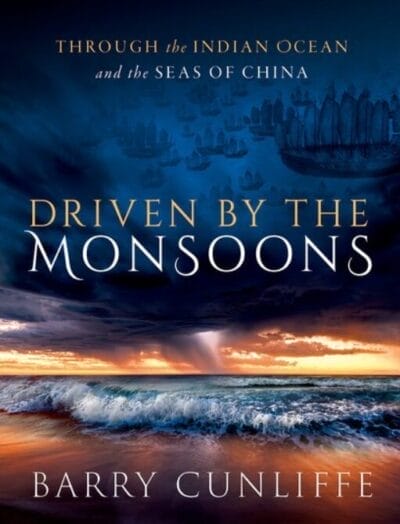
We look at the new book by Barry Cunliffe. See more about Driven by the Monsoons Through the Indian Ocean and the Seas of China here.
Driven by the Monsoons Through the Indian Ocean and the Seas of China, reviewed
This is a lovely book, well illustrated and joining up lots of dynasties and different forces playing out across time, both physically and geopolitically. The maps are nicely done, and there are also some lovely photos of many of the various locations mentions in the book. The author tackles a wide scope of locations, people, weather systems and timeframes. This does mean that there is a lot going on, and to keep up with. It is probably a book that might need several passes and a few reads depending on which aspect you wanted to know more about. For the author this does mean it is an impressive and wide ranging piece of research, that he has distilled down into a succinct and valuable work.
Much like Robert Macfarlane’s writing on sea paths, blue highways as such, mainly for the Atlantic seas, Barry Cunliffe delivers a very granular examination of similar sea routes for the Indian Ocean and Chinese waters. This encompasses many, many epochs and the rise and fall of different empires, even if, at times, it is of course much more challenging to document travels undertaken by boat upon water. Cunliffe does a successful job to make this subject accessible, and interesting too. This book could make a lovely gift or something that you might just want to hold onto for yourself too.
More about the book
The Silk Road may be one origin of globalization, but the Indian Ocean is another. Barry Cunliffe examines the beginning of maritime trade using the evidence of archaeology and the tales of great travellers such as Marco Polo, Ibn Battuta, and the Chinese Admiral, Zheng He. This story complements that of the land routes, showing how humans have been driven across thousands of years to create and maintain networks whatever the difficulties.
Driven by the Monsoons illuminates maritime connections between the Indian Ocean and its surrounding water routes: the Arabian Gulf and the Red and China Seas. It begins with the movement of humans into South-East Asia and ends about 1600 CE when European companies emerge to takeover. It is tale of exotic goods, material needs, adventure, and desire.
While conditions at sea and the abilities of the maritime communities provided a degree of stability, the direction and intensity of trade and the types of commodities on the move was determined by the fortunes and aspirations of distant empires, those of China in the east and South-West Asia and the Mediterranean in the west. This ever-changing pressure provided the dynamic situation in which society and economies in East Africa, India and South-East Asia flourished. Driven by the Monsoons explores the birth of the modern, connected, world.
More about the author
Barry Cunliffe taught archaeology in the Universities of Bristol and Southampton and was Professor of European Archaeology at the University of Oxford from 1972 to 2008, thereafter becoming Emeritus Professor. He has excavated widely in Britain (Fishbourne, Bath, Danebury, Hengistbury Head, Brading) and in the Channel Islands, Brittany, and Spain, and has been President of the Council for British Archaeology and of the Society of Antiquaries, a Governor of the Museum of London, and a Trustee of the British Museum. He was a Commissioner of English Heritage from 2005 to 2013. His many publications include The Ancient Celts (1997, second edition 2018), Facing the Ocean (2001), The Druids: A Very Short Introduction (2010), Britain Begins (2012), By Steppe, Desert, and Ocean (2015), The Scythians (2019), and Facing the Sea of Sand (2023), all published by Oxford University Press. He received a knighthood in 2006.
See more reviews here.
